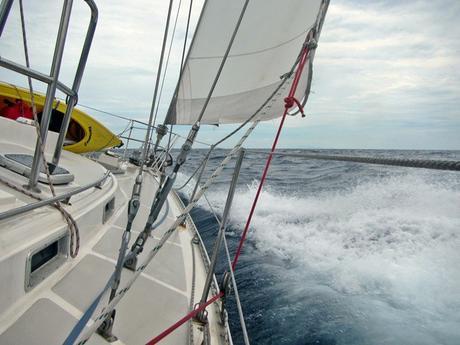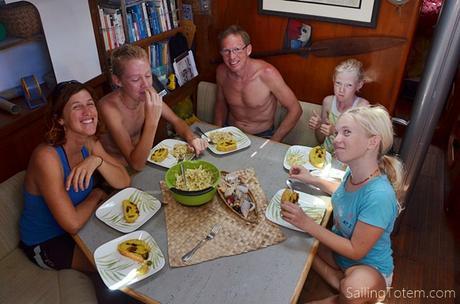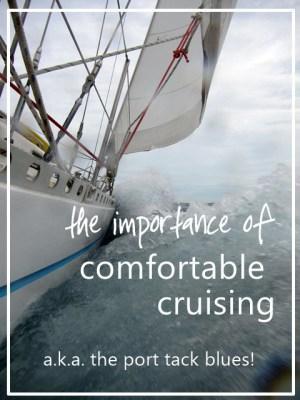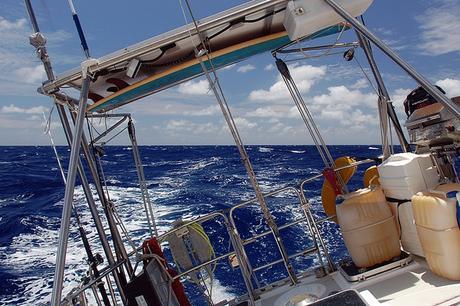
Flat water and a consistent breeze provided glorious sailing back in Madagascar. Daily diurnal winds power our passage south on a port tack in the morning and a starboard tack in the afternoon, with a brief period of calm between the directional switch. Totem’s comfortable motion in these conditions have made meal preparation in the galley easy when we’re underway, and we’re eating very well; having a French crew, Aline, join us for a stretch of the Madagascar coast brought a distinct flair to meals with crepes, brioche, and more added to our repertoire.
Aline is new to cruising but embracing it in a big way by taking seven months off to join a boat from Reunion on a loop through a number of Indian Ocean destinations. We borrowed her company for a week, and enjoyed her fresh perspective on our life afloat as she considers her own plans for the future. It’s carefully ladling crepes with Aline one morning and talking in general about the cruising life that I spit out: “I hate cooking on a port tack!”

Aline and Siobhan making crepes in our port-tack-unfriendly galley
Well, we’re on a port tack, it’s a beautiful morning, and we have no problem cooking at all. But put Totem in any kind of sea state, or moderate heel, and working in the galley gets challenging – especially when heeling to starboard. The galley runs fore and aft along our left side of the main cabin; this angles the face of the cabinets down. Fiddles aren’t always enough to keep cutlery and dishes in place, and contents have been known to leap out when they weren’t wanted. I have been known to swear like, well, a sailor when this happens.
Aline sees time and enjoyment that go into preparing meals on Totem from a different angle: they fuel family time and represents the comfortable, cozy environment we try to foster on board. Our meals this week have ranged from Moroccan style chicken and couscous to a heavenly beef stew that Jamie conjured from local zebu, the long-horned cattle that are everywhere in Madagascar. We’ve been baking almost daily, making everything from focaccia to fruit tarts. Of course, we’ve also had benign conditions, so it’s not been difficult; my outburst about port tack cooking seems out of place.

brioche stuffed with olives and sun-dried tomatoes. YUM.
The boat Aline’s been crewing on is a sleek speed demon; it puts the miles away, but one tradeoff (everything on a boat is a compromise!) are some creature comforts. Their crew loves good food as much as we do, but their galley is more awkward to use. Space to prep is limited, so meals tend to be one-pot. Underway it’s usually the only option, because the stove requires someone to pay constant attention to ensure dinner doesn’t end up on the cabin sole. It’s a light, fast boat so stowage is deliberately curtailed; we’ve got the room and the tolerance to carry a large range of condiments and ingredients stashed in Totem’s lockers. Comparing life on the two boats, meals strikes Aline as analogous for how Totem is not just a vessel enabling adventures afloat, as her host vessel is, but a home.
Granted, this is a luxury we have: Totem IS our home, as opposed to a short-term platform to adventure. Beyond some boxes, photos, and a single piece of furniture stashed in my parents’ attic, everything we own is on board. Our settees covered with are a warm pattern, with batik covers for the seats that hearken to our time in Southeast Asia. Colorful throw pillows make it easy to find a cozy place to curl up with a book. There are carvings and other souvenirs from our travels on display, and framed artwork secured to bulkheads. We have a more than two dozen linear feet of bookshelf space.

for the record, it’s almost never this clean.
By contrast, the other boat—a sleek monohull the same length as Totem—is a modern design with minimalist aesthetic. The neutral-toned interior has a minimum of personal touches: a few drawings on the wall, a couple of pieces of tourist art. The only books on board are those necessary for navigation or equipment maintenance (crew are encouraged to bring e-readers rather than add weight/volume to the gear on board).
Totem is vibrant (and maybe a little chaotic) by comparison, but wasn’t always this way. When we bought her the interior had no personality; just a generic poster print framed on one bulkhead. But when a boat is home, and not just a temporary escape, modifications to adapt it to your style and your needs are important.

Aline helps me appreciate other aspects of Totem that I take for granted, but which to her make it a welcoming environment for living—like our locker full of arts and crafts supplies, soft bedding in the bunks, a workstation to comfortably use a computer (and, one that’s independent from the navigation station), and the music that goes on when the sun gets low and we gather in the cockpit.

why do we seem to spend so much time on a port tack, anyway?
What’s important to make Totem work for our family is unique to our desires. Aline’s observations remind me how our first cruising boat didn’t have many of these adaptations; but it met our needs, as they were at the time. Had we taken months for that inland passage adventure (someday!), it would have been more important. As it is now? If the frustration of cooking on a port tack is among my biggest complaints for comfortable living afloat, I think we’re doing pretty well.
Siobhan’s take on port tack living aboard Totem is simple. “Well, mama starts swearing, and we don’t eat as much.” Ouch. We have 1,200 miles ahead from here to South Africa, through some of the most notorious waters of the world, and most of it will be- naturally- on a port tack.
I think I’ll go can up some stew now.
Jamie and I co-author the cruising column for 48° North, a Pacific Northwest boating magazine. This post is slightly adapted from our article in the October issue. Unfortunately we’ll probably have a LOT of port tack miles ahead in 2016, too! 48° North is available free online, or on newsstands in salty spots around the Salish Sea.
This post is syndicated on Sailfeed.

